
Have you ever walked into your regular grocery store and cringed because they rearranged the store? You find dog food in the bread aisle and paper plates where the cereal used to be. Everything you need is still in the store, but it’s hard to find, which can be frustrating.
Something similar happens when authors write books without structure—readers “walk in” to the story expecting to find three acts or mirroring plot points, but instead they find vignettes or backstory. If it’s a favorite author—like your regular grocery store—they might stick around and try to find their way through the mess, but if it’s someone new to them, chances are good that they’ll walk out and find a story that’s less frustrating.
In his book Just Write, James Scott Bell says structure is important for the reader, not the writer. Whether or not they realize it, readers have specific expectations for novels. They expect the boy and girl to live happily ever after in a romance. They detective must find the criminal in a mystery. Historical events need to impact the characters in historical romance.
All of those elements are part of a novel’s structure. Recognizing and understanding different story structures will help you create a solid foundation on which to build your novel.
As with most things in fiction writing, there’s no one-way to do things. There are different types of story structure you can use, and they all work. A good place to start is the traditional three-act story.
A three-act story actually includes at least six main points, but the three most obvious are the acts.
Act I: The introduction—this is where you introduce the setting and main characters.
Act II: The body—where the story happens (and conflict reigns).
Act III: The conclusion—the climax of the story where everything resolves.
But you also need some transitional elements.
Inciting Incident: Something out of the ordinary that forces the main character into the story.
First Door: A situation requiring a decision that pushes the MC from Act I into Act II.
Second Door: A life-changing decision that forces the MC into Act III (it doesn’t matter what the MC chooses, life will be different; it’s his choice as to how it will be different).
Most readers cand identify these elements, but the subconsciously look for them, and including them in your book helps them more easily navigate new settings, new characters, and a new author voice.
The are many variations of the three-act plot, and they all work. The key is to find the structure model that works best for you and your story. I’ve listed some of my favorite resources for structure below—what’s your go-to book for plot structure?
AVAILABLE NOW! Get your copy here!
 If you’re looking to strengthen your writing and self-editing skills, here’s what you can expect in How to Edit Your Novel:
If you’re looking to strengthen your writing and self-editing skills, here’s what you can expect in How to Edit Your Novel:Take your self-editing skills to the next level.
• Have you eliminated all the telling?
• Are the characters complex?
• Is every scene necessary?
Most authors will answer ‘yes!’ to these questions. But then editors and readers tell them the descriptions don’t engage them, the characters are stereotypical, and the story dragged.
How do you fix it?
Self-editing can only take you so far. But if you know the right questions to ask and you know how to interpret the answers, you’ll not only strengthen your self-editing skills, you’ll strengthen your writing.
HOW TO EDIT YOUR NOVEL doesn’t simply rehash the fiction-writing basics that create good stories-it provides examples, context, and questions that will help authors identify and strengthen their weaknesses the same way a professional editor tackles a manuscript. By combining mini writing lessons with practical self-editing tips, everything a writer needs to become a better self-editor is practically presented.
Whether you’re a new writer or an experienced author, HOW TO EDIT YOUR NOVEL can help you polish your story into a gem agents, publishers, and readers will want to keep reading.
” … bound to be a book you keep right next to your keyboard …. ”
–Cristel Phelps, Managing Editor for Fiction, Elk Lake Publishing, Inc
Plot and Structure by James Scott Bell
Save the Cat! Writes a Novel by Jessica Brody
How to Write a Novel Using the Snowflake Method by Randy Ingermanson


